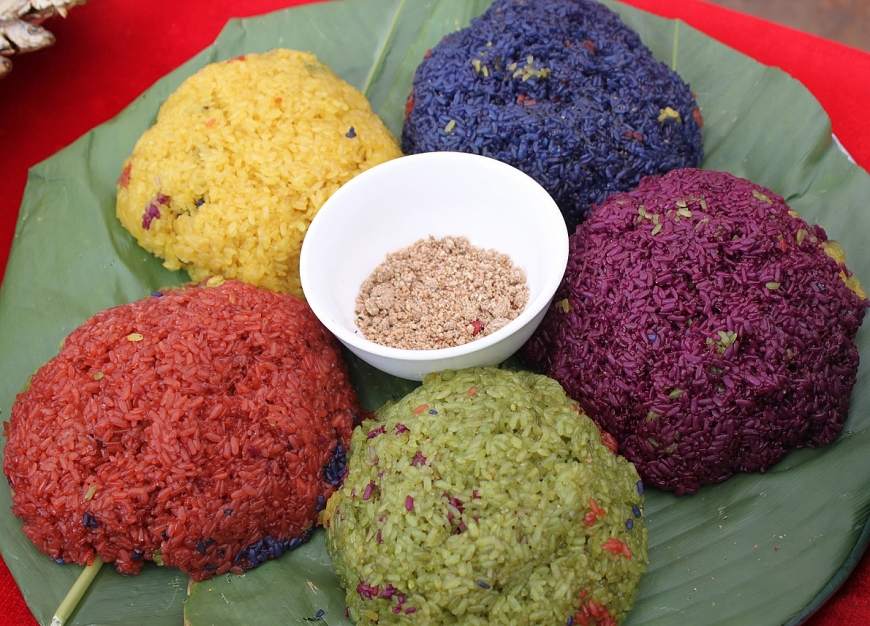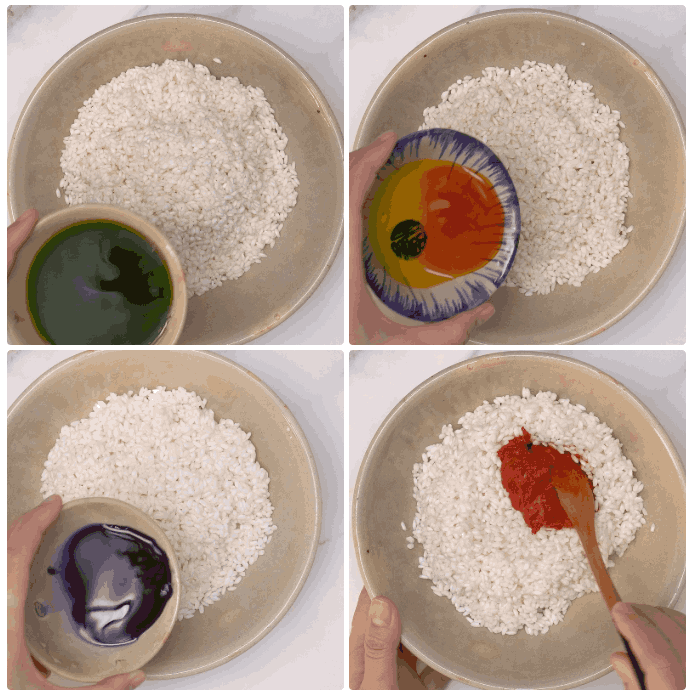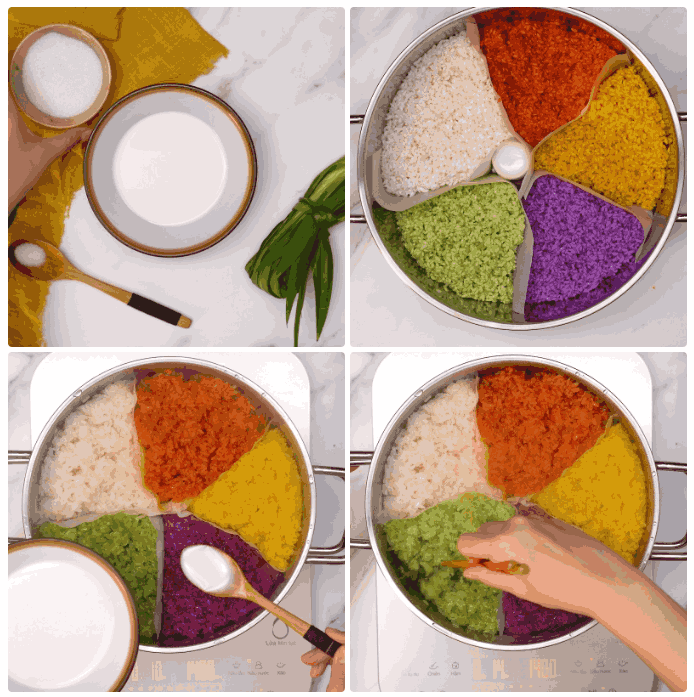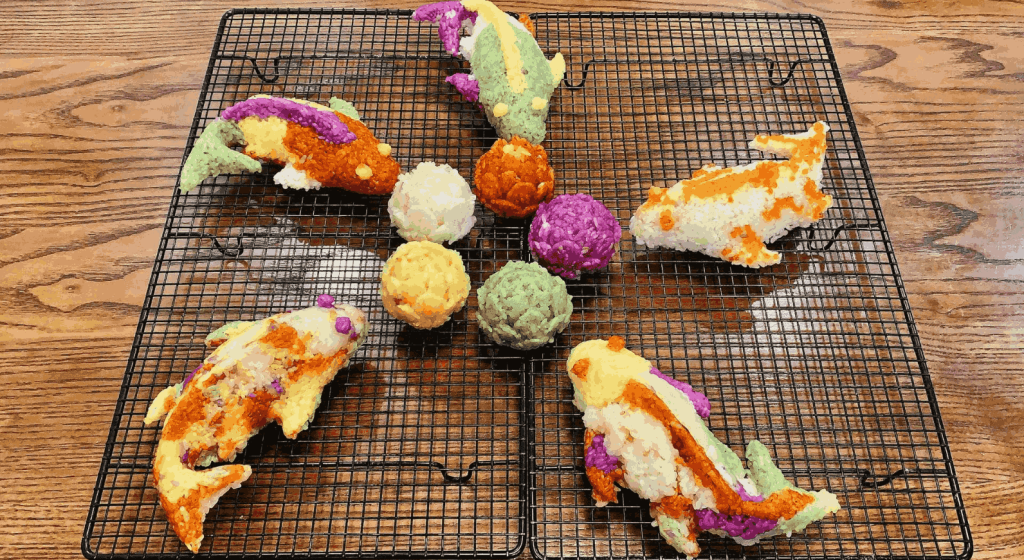If you have ever dreamed of traveling to Ha Giang, you have likely heard of Five-Colored Sticky Rice – a traditional dish created by the Tay, Nung, and other ethnic groups. Not only known for its vibrant colors and fragrant flavor, Five-Colored Sticky Rice also reflects the deep cultural roots and everyday life of the highland people. In this article, Phieu Travel shares the story, the natural ingredients, and the meticulous craft behind this meaningful dish.
1. Five-Colored Sticky Rice – A cultural symbol of the highland communities
In Ha Giang’s highlands, Five-Colored Sticky Rice is closely tied to the traditions of the Tay, Nung, and Dao people. Prepared for Tet, spring festivals, and family gatherings, the dish uses natural colors from forest leaves, with each shade carrying wishes for health, prosperity, or harmony. Making and sharing sticky rice has remained a living tradition across generations.
Outside of festivals, Five-Colored Sticky Rice serves a practical need. Farmers pack it for long hours in the fields, relying on its lasting texture and rich flavor to stay nourished throughout the day.
The Ultimate Ha Giang Loop Guide (2025): Itinerary, Map & Tips
2. The sacred meaning behind each color in Five-Colored Sticky Rice
Each color in Five-Colored Sticky Rice reflects a part of the highland people’s worldview, blending hopes for life, nature, and family into a single dish. These five colors also correspond to the five fundamental elements in Eastern philosophy: metal, wood, water, fire, and earth – symbolizing the balance between heaven, earth, and human beings.
- Red (Fire): Represents vitality, courage, and the desire for a flourishing future. It reflects the community’s enduring spirit in facing the hardships of mountain life.
- Yellow (Earth): Symbolizes prosperity and peace. Yellow rice is often placed at the center of the serving, honoring the land as the source of life and abundance.
- Green (Wood): Reflects forests, fields, and the dream of fertile crops. Green sticky rice conveys a deep connection to nature and prayers for a thriving harvest.
- Purple (Water): Stands for fertile land and the value of preserving rivers and streams. It reminds people of the importance of water in sustaining both agriculture and community life.
- White (Metal): Expresses loyalty, filial piety and purity of heart. White rice honors ancestors and the moral roots passed down through generations.

3. Ingredients of Five-Colored Sticky Rice
Five-Colored Sticky Rice is made from premium glutinous rice, selected for its soft texture, fragrant aroma, and ability to stay tender after hours of steaming. Thanks to generations of experience, the Tay people create sticky rice that is rich, slightly nutty, and naturally fragrant.
Natural ingredients are used to dye the rice: gac fruit or red cẩm leaves for red, turmeric or bó phẩn flowers for yellow, ginger leaves, pandan leaves, or butterfly pea flowers for green, and purple cẩm leaves for purple. The white color comes from pure sticky rice without any dye. These natural dyes, extracted from forest leaves and flowers, are also believed to support digestion and improve overall health.
Ha Giang in August: Weather, Things to Do & Travel Tips
4. The complex preparation process of Five-Colored Sticky Rice
The preparation of Five-Colored Sticky Rice starts with soaking premium glutinous rice in clean spring water for six to eight hours. After soaking, the rice is divided into five portions, each dyed with natural extracts from leaves, fruits, or roots to create distinct colors.

To maintain color purity, each plant ingredient must be pounded, strained and processed separately. During steaming, the rice is layered carefully: fragile colors are cooked first, stronger ones follow, and the white rice is placed at the top to prevent staining.
Managing the fire and timing the steam are critical steps, requiring experience passed down through generations. The goal is to keep the rice soft, evenly cooked, and naturally fragrant, without losing the brightness of each color.

After cooking, the sticky rice is arranged into shapes like flowers or layered hills, depending on family traditions. These presentations often appear at important events, symbolizing wishes for prosperity, happiness, and unity within the community.

5. Best time to enjoy Five-Colored Sticky Rice in Ha Giang
The best time to experience Five-Colored Sticky Rice in Ha Giang is during major festivals and harvest seasons. From late January to February, Tet celebrations bring vibrant dishes to every village. In October and November, the Buckwheat Flower Festival offers visitors a chance to taste local specialties, including freshly made sticky rice. Spring and autumn are also ideal, as the highland climate enhances both the flavor and the festive spirit.
6. Experiencing Five-Colored Sticky Rice with Phieu Travel
In each journey organized by Phieu Travel, we always make sure that our guests have the chance to experience the local specialties of Ha Giang, such as Five-Colored Sticky Rice. Travelers are invited to participate in the full process – from soaking the rice, dyeing it with forest leaves, to steaming and presenting it. This hands-on experience offers more than just a meal; it’s a chance to understand the cultural significance behind the dish.
Through our Ha Giang Loop tours, visitors can meet local families in remote villages and see the genuine tradition of making Five-Colored Sticky Rice passed down through generations. Whether it’s participating in the preparation process or simply enjoying a warm bowl of rice, these moments offer a deeper connection to the culture and people of Ha Giang.
Phieutravel.com has introduced you to Five-Colored Sticky Rice – a traditional dish rich in cultural meaning from Ha Giang’s highlands. We hope the insights into its significance, ingredients, and intricate preparation have deepened your understanding. Stay tuned for more articles from us to explore the culture and cuisine of Vietnam’s northernmost region!
Read more:
- Thang Co – The H’Mong People’s 200-Year-Old Exotic Stew
- Ha Giang stone cake: How to prepare this unique highland delicacy
- Men Men of Ha Giang: Discover the Hmong’s traditional soul food
- Then Pa Village Ha Giang the essential guide to this hidden h’Mong gem
- Lung Ho, Ha Giang complete guide to Vietnam’s Hidden Gem
- Ha Giang’s Buckwheat Cake: Heritage, Flavor, and How to Try It


You Might Also Like
Ha Giang Weather in September: Complete Guide for Travelers
Exploring the magnificent Ha Giang Loop in September offers travelers a perfect balance of favorable[...]
Quan Ba Twin Mountains: Ha Giang’s Iconic Fairy Hills and Complete Travel Guide
The mystical Quan Ba Twin Mountains rise from the emerald valleys of Ha Giang like[...]
Vuong family mansion: the architectural marvel and cultural legacy of Ha Giang
Deep in Vietnam’s northern highlands, where mist-shrouded mountains meet terraced rice fields, stands a testament[...]
Ha Giang Loop Safety Tips: How to Ride Securely in Vietnam’s Northern Mountains
The Ha Giang Loop, with its winding mountain roads and breathtaking landscapes, offers one of[...]
The Ultimate Guide to the M-Shaped Curve on Ha Giang Loop
Vietnam’s remote northern province of Ha Giang hides a natural wonder that has captivated adventurous[...]
Most Beautiful Places to Visit in Vietnam: Essential Destinations and Insider Tips
Vietnam captivates travelers with its stunning landscapes, rich cultural heritage, and warm hospitality. From mist-shrouded[...]
Beyond the Beaten Path: Discovering Ha Giang Province in Northeast Vietnam
Ha Giang Province in Northeast Vietnam stands as one of the country’s last frontiers for[...]
Rainy season in Ha Giang: what to expect, when to go, and travel tips
Vietnam’s northern frontier reveals a different face during the rainy season, transforming Ha Giang’s limestone[...]